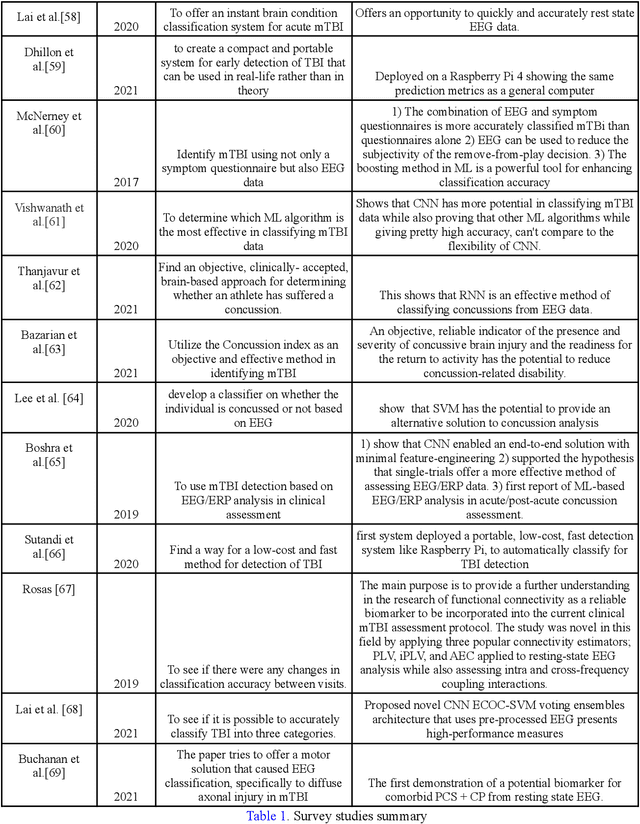Ryan Chang
EEG Machine Learning for Analysis of Mild Traumatic Brain Injury: A survey
Aug 10, 2022



Abstract:Mild Traumatic Brain Injury (mTBI) is a common brain injury and affects a diverse group of people: soldiers, constructors, athletes, drivers, children, elders, and nearly everyone. Thus, having a well-established, fast, cheap, and accurate classification method is crucial for the well-being of people around the globe. Luckily, using Machine Learning (ML) on electroencephalography (EEG) data shows promising results. This survey analyzed the most cutting-edge articles from 2017 to the present. The articles were searched from the Google Scholar database and went through an elimination process based on our criteria. We reviewed, summarized, and compared the fourteen most cutting-edge machine learning research papers for predicting and classifying mTBI in terms of 1) EEG data types, 2) data preprocessing methods, 3) machine learning feature representations, 4) feature extraction methods, and 5) machine learning classifiers and predictions. The most common EEG data type was human resting-state EEG, with most studies using filters to clean the data. The power spectral, especially alpha and theta power, was the most prevalent feature. The other non-power spectral features, such as entropy, also show their great potential. The Fourier transform is the most common feature extraction method while using neural networks as automatic feature extraction generally returns a high accuracy result. Lastly, Support Vector Machine (SVM) was our survey's most common ML classifier due to its lower computational complexity and solid mathematical theoretical basis. The purpose of this study was to collect and explore a sparsely populated sector of ML, and we hope that our survey has shined some light on the inherent trends, advantages, disadvantages, and preferences of the current state of machine learning-based EEG analysis for mTBI.
Machine Learning-based EEG Applications and Markets
Aug 10, 2022



Abstract:This paper addresses both the various EEG applications and the current EEG market ecosystem propelled by machine learning. Increasingly available open medical and health datasets using EEG encourage data-driven research with a promise of improving neurology for patient care through knowledge discovery and machine learning data science algorithm development. This effort leads to various kinds of EEG developments and currently forms a new EEG market. This paper attempts to do a comprehensive survey on the EEG market and covers the six significant applications of EEG, including diagnosis/screening, drug development, neuromarketing, daily health, metaverse, and age/disability assistance. The highlight of this survey is on the compare and contrast between the research field and the business market. Our survey points out the current limitations of EEG and indicates the future direction of research and business opportunity for every EEG application listed above. Based on our survey, more research on machine learning-based EEG applications will lead to a more robust EEG-related market. More companies will use the research technology and apply it to real-life settings. As the EEG-related market grows, the EEG-related devices will collect more EEG data, and there will be more EEG data available for researchers to use in their study, coming back as a virtuous cycle. Our market analysis indicates that research related to the use of EEG data and machine learning in the six applications listed above points toward a clear trend in the growth and development of the EEG ecosystem and machine learning world.
 Add to Chrome
Add to Chrome Add to Firefox
Add to Firefox Add to Edge
Add to Edge